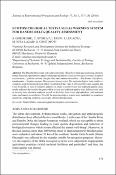Options
Ecotoxicological tests used as warning system for Danube Delta quality assessment
Date issued
2016
Abstract
The Danube Delta water and sediment toxicity effects have been assessed using a biotests
battery based on representative species of primary producers (Selenastrum capricornutum, Sorghum
saccharatum, Lepidium sativum, Sinapis alba) and consumers (rotifers – Brachionus calyciflrus,
crustaceeans – Daphnia magna, Heterocypris incongruens). The ecotoxicological tests results revealed no acute to minimum toxic effect classified as Class I and II of hazard for water samples and
Class II and III, in case of sediment samples. In order to control water and sediment-quality, these
results indicated the need to integrate within a water and sediment-quality triad different tests such
as toxicity tests, chemical analyses as well as field data from water phytoplankton, soft-sediment
meio- and macro-invertebrates. Overall, the ecotoxicological results were modulated by organisms
sensitivity, sampling locations, season and climate change issues.
battery based on representative species of primary producers (Selenastrum capricornutum, Sorghum
saccharatum, Lepidium sativum, Sinapis alba) and consumers (rotifers – Brachionus calyciflrus,
crustaceeans – Daphnia magna, Heterocypris incongruens). The ecotoxicological tests results revealed no acute to minimum toxic effect classified as Class I and II of hazard for water samples and
Class II and III, in case of sediment samples. In order to control water and sediment-quality, these
results indicated the need to integrate within a water and sediment-quality triad different tests such
as toxicity tests, chemical analyses as well as field data from water phytoplankton, soft-sediment
meio- and macro-invertebrates. Overall, the ecotoxicological results were modulated by organisms
sensitivity, sampling locations, season and climate change issues.
Files
Loading...
Name
JEPE_2016_1_171-181.pdf
Size
584.78 KB
Format
Adobe PDF
Checksum
(MD5):c340157a319c86c29640311b93e8e7b5